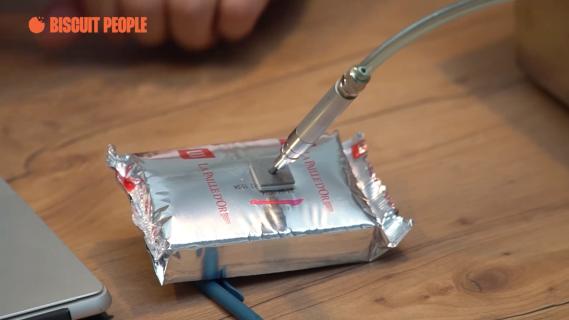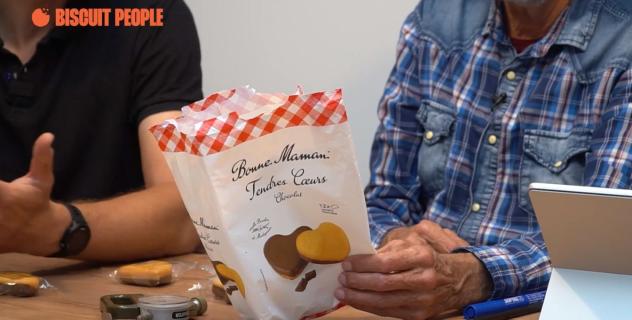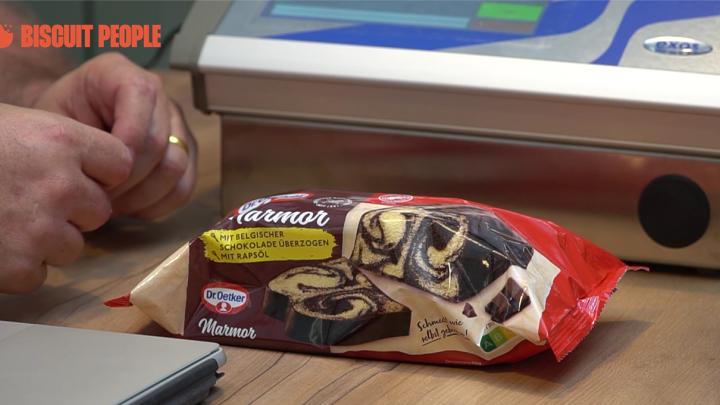Episode 1: Mramor Cake
Welcome, everyone, to the third season of our podcast! Biscuit experts Jacob van Kogelenberg, Eric Schaller, and Jos Vast will be our guests through the whole season so let's see what they have to say
In the first episode we will be talking about Mramor Cake. This soft, delicious cake has many aspects worth discussing. We'll share the findings from our hermeticity tests conducted on the exos machine, explore its composition and shelf life, and conduct a thorough packaging analysis. So let's see what Mramor Cake is all about!
Shelf Life and Composition
The product's shelf life is roughly estimated at three to four months based on its packaging date of January 7, 2024. By analyzing the nutritional values, we determined that the cake has about 17% residual moisture and 11% chocolate coating.
Jos explained: "They use some humectants such as glycerine and and sorbitol in there. They are also very good in keeping moisture inside the products, but also lowering water activity. And they regulate the the the acidity and the pH of the product with, sodium acetate. So that will already tell us that this product is made for keeping for a longer period of of time."
Typically, a water activity level of around 0.8 is expected for such products, correlating to a shelf life of about 40 days with a neutral pH. However, the modified atmospheric packaging likely extends this shelf life. Since water activity level cannot be tested, what changes in terms of shelf life if the levels are below 0.8?
But if if you look at the the pack itself, are there any any flaws here?
Packaging Analysis
"So if I try to pull apart the thin seal, you'll see it's delaminates. I cannot pull apart the thin seal. So it's a good seal. It is, 60 micron. I measured it already before, but I'll do it again", said Jacob van Kogelenberg.
We're talking about 60 micron thickness of the material, which I estimate means that we have either 2 times 30 or 40 20. That's irrelevant. And this is a I mean, it looks like a pearlized film on the inside, so that probably will be 40 and a reverse printed transparent film on the outside. And there could be, of course, EVOH layer in between to, improve the barrier property of the film itself. So that's, that's where we will go."
Jacob observed that the pack had less headspace than expected, which could affect mechanical protection and CO2 storage. Despite this, the package maintained its integrity with a very low defect size of 15 microns. Notable areas of potential leakage, such as wrinkles in the seal, did not significantly impact the product’s hermeticity. This suggests high-quality packaging.
So let's test this pack with the amazing exos!
Eric explained what will the test show: " We will do a complete test of gas analysis. So oxygen plus CO2 plus leak leak tests and the burst tests. So the leak test is to check that the is there, and, you will not lose half of your modified atmosphere, basically. So it is standardized test, so we will keep the pressures, steady, within the pack by adding air in proportion of the leak, through the defects of the pack. And, finally, the burst, which is the peak pressure of, the peak pressure we achieved before opening of of the of the pack, basically."
Testing Results
During the tests, the pack showed more than 20% CO2, indicating an acidic condition beneficial for preservation. The leak rate was below 20 microns, close to the detection limit of the instrument. The burst test revealed a peak pressure of 274 millibars, but the pack did not burst, suggesting delamination. Overall, the packaging performed well, maintaining its condition even after six weeks.
Conclusion
Minor changes in packaging material and manufacturing settings could enhance product quality without substantial investment. From a formulation perspective, adjusting water activity and pH could further improve shelf life without altering the taste. Combining these strategies can provide a longer shelf life and better product stability, ensuring consumer satisfaction.
What are the variables a company can try to change for optimization of shelf life? Let's find out!

This time, the focus is on the unique challenges presented by LU La Paille d’Or — a delicately crisp wafer biscuit filled with raspberry j...

Join us for an in-depth exploration of Bonne Maman's Tender Hearts, where we go beyond the surface of these delightful treats to uncover the scien...

In this episode of the Biscuit People Podcast, we are offering a new perspective that goes beyond simply focusing on the product or packaging in isola...
